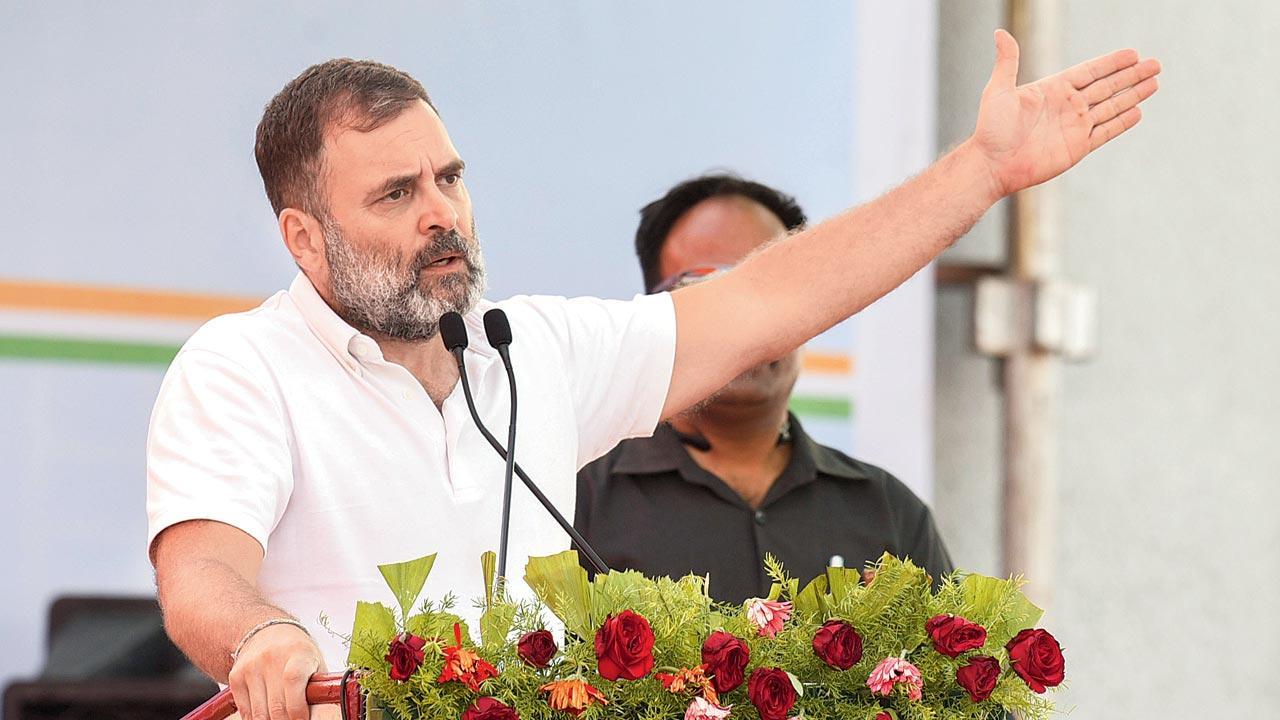The party envisions a country where power is distributed more equitably among social groups than today, and the domination of the upper castes reduced in India’s life

Congress leader Rahul Gandhi addresses a public meeting in support of party candidate Praniti Shinde, in Solapur, Wednesday. Pic/PTI
 The Congress manifesto imagines an India where social relations will be altered dramatically, and power among social groups distributed more equitably than today. These changes will, in the long run, undermine the domination of the upper castes in India’s life. But this transformation cannot come until the Congress-spearheaded INDIA comes to power. Yet its manifesto is worthy of academic study as it outlines, with daring strokes, an India of the future for the people to consider.
The Congress manifesto imagines an India where social relations will be altered dramatically, and power among social groups distributed more equitably than today. These changes will, in the long run, undermine the domination of the upper castes in India’s life. But this transformation cannot come until the Congress-spearheaded INDIA comes to power. Yet its manifesto is worthy of academic study as it outlines, with daring strokes, an India of the future for the people to consider.
ADVERTISEMENT
It’s no surprise that the Congress manifesto promises to conduct a nationwide Socio-Economic and Caste Census. This Congress leader Rahul Gandhi has been advocating over the last one year, with the passion typical of neo-converts. Given the example of Bihar, where the Caste Census was carried out last year, we know such an exercise nationwide will reveal a wide gulf in employment, wealth and educational attainments among groups down the caste hierarchy.
“Based on the [Caste Census] data, we will strengthen the agenda for affirmative action,” the Congress manifesto says. It could have stopped at this anodyne assertion. But no, it explicitly spells out the affirmative action measures, as if inviting the people to imagine the degree to which the existing socio-economic reality can be altered under the existing constitutional arrangement.
The Congress promises it would amend the Constitution to remove the 50 per cent cap on caste-based reservation the Supreme Court imposed. This proposal requires to be decoded. The Mandal Commission estimated the population of the Other Backward Classes to be 52 per cent of India’s. In order not to violate the Supreme Court orders on the 50 per cent cap, and with the Scheduled Castes and the Scheduled Tribes already accounting for 22.5 per cent reservation, the Commission recommended a 27 per cent quota for the OBCs.
A caste Census will put a definite figure to the OBC population, which will be well beyond 27 per cent. There will rise a clamour to match the OBC quota with their population, only possible by removing the cap. The removal of the 50 per cent cap implicitly supports a reconfiguration of the quantum of reservation, and addition of a new reservation category to accommodate socially and educationally advanced groups, such as the Marathas, Jats, Kapus and Patels, which have been agitating for a share in the reservation cake. The removal of the cap will have India leap towards proportional representation in government jobs and educational institutes.
In such a scenario, the jobs for the General Category will diminish. In 2022, according to official figures, those belonging to this category, which the upper castes dominate, accounted for 65 per cent of Group A and 61 per cent of Group B jobs. The shrinking of the General Category in the bureaucracy will, thus, lead to a concomitant reduction in the power of the upper castes.
But the Congress manifesto does not stop there, for it says it will make the 10 per cent reservation for the Economically Weaker Section accessible to those groups not entitled to it. These are precisely the groups already availing reservation. Another site of the upper-caste domination is the private education sector, where caste-based reservation has not been introduced despite the constitutional provision—Article 15 (5)—for it being there. The Congress manifesto assures Article 15 (5) will be implemented.
Reservation has been steadily losing its lure for people as the government sector has been contracting after liberalisation. To counter this perception, the Congress promises to regularise contractual jobs. In 2022, contract and casual workers accounted for 43 per cent of jobs in Central public sector enterprises. In 2021, as many as 24.3 lakh workers were on contract in “Central sphere establishments” such as the Railways, ports, mines, etc.
Contractual jobs are outside the reservation pool. Their regularisation will boost not only employment, but also enhance the quantum of reserved jobs. In addition, the Congress promises to fill vacancies in Central government jobs. There were 8.7 lakh such vacancies in March 2020. Here too, obviously, reservation will apply.
Should INDIA come to power, the Congress will not find its allies erecting obstacles to its intention of promoting social justice. The Congress is, in fact, amplifying ideas which its allies had initially advocated or introduced. It is also unlikely the Congress will pussyfoot around its proposals, for its decision to swing to the Hindu Left, so to speak, is influenced by the compulsion to carve out a new social base for itself. For far too long, the Congress waited for the upper castes, which deserted the party 1990 onward, to return to its fold. It now wants to invent a new future for itself—and India.
The Congress’ plan to reforge social relations will meet stiff opposition, already presaged by the controversy triggered over its manifesto, which emphasises more on altering power equations between castes than wealth distribution. Imagine the backlash the Congress’ proposals would trigger in case these are implemented. It will countenance the fury of the upper castes and lengthy battles in the Supreme Court. Our judicial history shows the apex court has rarely annulled the policies of those in power. That is why without power, a party’s manifesto, ultimately, becomes a fantasy only of academic interest.
The writer is a senior journalist
Send your feedback to mailbag@mid-day.com
The views expressed in this column are the individual’s and don’t represent those of the paper
 Subscribe today by clicking the link and stay updated with the latest news!" Click here!
Subscribe today by clicking the link and stay updated with the latest news!" Click here!







